#iniwriverlot11
Explore tagged Tumblr posts
Text
Kids connect with Edmonton’s past, present & future

(The Virginia Park Elementary School Grade 5 class with Amy Malbeuf’s Iskotew - photo courtesy of City Hall School)
They journaled, they jumped, and they connected with the stories of this place.
The Grade 5 class from Virginia Park School visited ᐄᓃᐤ (ÎNÎW) River Lot 11∞, Edmonton’s Indigenous art park, earlier this month. Facilitated by Edmonton Arts Council Public Art Officer Chelsea Boida, the tour guided the students through the six artworks within Queen Elizabeth Park.
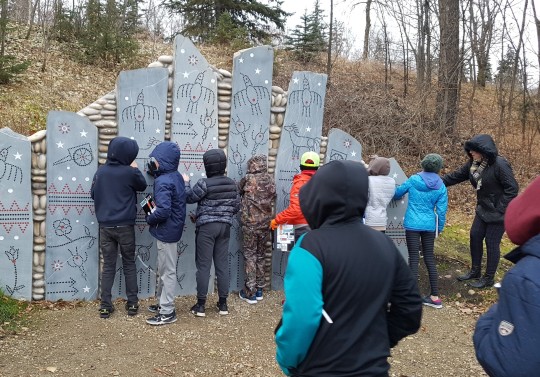
(Students explore Marianne Nicolson’s Preparing to Cross the Sacred River at ᐄᓃᐤ (ÎNÎW) River Lot 11∞ - photo courtesy of City Hall School)
The tour was one of many activities in which the class participated during their week at City Hall School. The immersive, hands-on program connects students to their city, curriculum and career pathways. Students not only spend a week in a dedicated classroom at City Hall, but also participate in curriculum enrichment activities throughout the school year. In addition to teaching kids about City Council and how municipal government works, the program offers arts-based activities as a way of animating subjects such as art, social studies, language arts, math, and science. For City Hall School, connecting students with Edmonton’s public art presents a creative way of encouraging imaginative learning.

(Student with journal - photo courtesy of the school)
The students are expected to actively engage with the subject matter by journaling about their impressions, thoughts and feelings. The visit to ᐄᓃᐤ (ÎNÎW) River Lot 11∞ inspired sketches and lively journal entries as well as commentary on the weather.
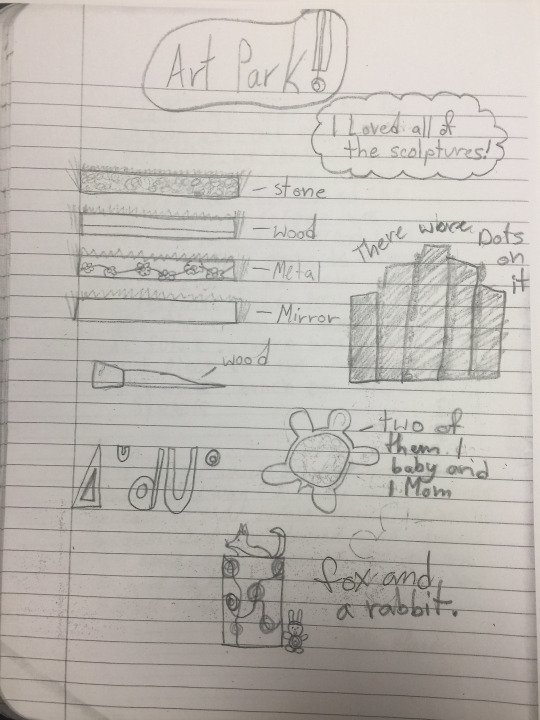
(Sketch page from a Virginia Park student’s journal)
“I liked going to the Indigenous art park and seeing the sculptures. I love the steps and the Cree dialect piece it was very cool”.
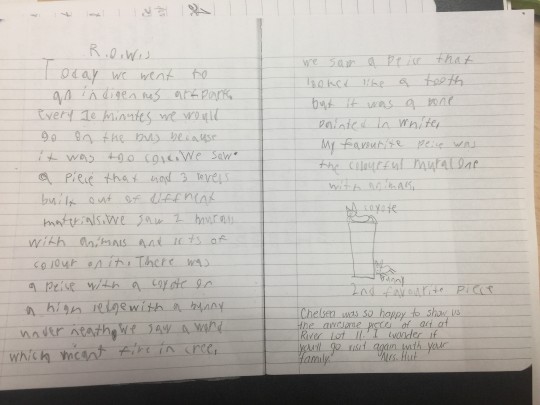
“Today we went to the Indigenous Art Park . Every 10 minutes we would go on the bus because it was so cold. We saw a piece that had 3 levels built out of different materials. We saw 2 murals with animals and lots of colour on it. There was a piece with a coyote on a high ridge with a bunny underneath. We saw a word which meant fire in Cree. We saw a piece that looked like a tooth, but it was a bone painted in white. My favourites were the colourful mural one with animals”.
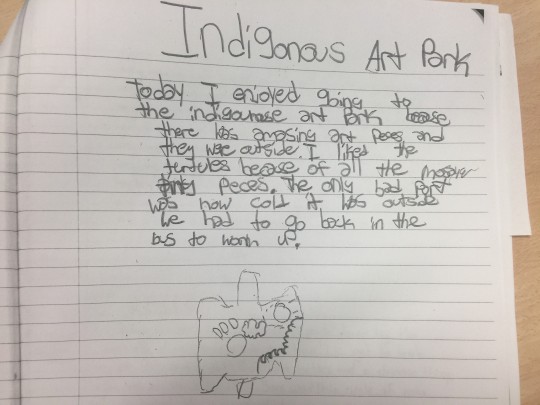
“Today I enjoyed going to the Indigenous art park because there was amazing art and they are outside. I liked the turtles because of all the mosaic pieces. The only bad part was how cold it was outside. We had to go back in the bus to warm up.”

(Colourful beaver detail of mamohkamatowin (Helping One Another) by Jerry Whitehead)
Parents are huge fans as well and, like their kids, journaled about the experience.
“The Indigenous Art Park was AMAZING. The wonderful use of creativity and the Cree language was very cool. That colorful little beaver on the turtle mosaics was a highlight for me. So colorful and happy”.

(Virginia Park Elementary School students with mikikwan, Duane Linklater’s reimagining of an ancient hide scraper - photo courtesy of the school)
“For me, today was very inspiring to be at the art park. I really feel that these are the first steps to making the connection with the citizens of Edmonton. A connection to healing the past, to move forward as partners in this great city. All of our lives are important and we all matter. A connection to the past, a connection to the past, and a connection to a great future together”.
You can follow the public art (and other) adventures of City Hall School on Twitter @CityHallSchool
City Hall School is one of 13 programs offered in Edmonton by Inquiring Minds.
#cityhallschool#yegarts#yegpublicart#iniwriverlot11#canadianindigenousart#indigenousart#publicart#amymalbeuf#duanelinklater#jerrywhitehead#edmontonpublicschoolboard#inquiringminds#yegdt#cityofedmonton#mariannenicolson
5 notes
·
View notes
Photo

#lunchtimewalks we have the best walking trails from Grow Centre. #iniwriverlot11 Join an established and diverse community for coworking, making or events. Serving @oldstrathcona since 2014! Link in profile #openconcept #privateoffice #clinicroom #workshop #meetingtable #hotdesk #freewifi #goodcoffee #downtobusiness #inclusive #growcentrecowork #growcentrecoworking #yeg #yeggers #coworking #coworkinglife #makerspace #coworkingspace #coworkingspaces #yegcoworking #coworkingwhyteave #coworkinggoals #digitalnomad #hatefreezone Meet some of our coworkers @pansypokeco @indigenousbirthab @steadyhanddoula @nikawismade @fancywoo @hillhandpoke @intended.oddities @freakmeats @kay.pokes (at ᐄᓃᐤ ÎNÎW River Lot 11∞ Indigenous Art Park) https://www.instagram.com/p/B3dHS6-gqT7/?igshid=1in5nbus99o3x
#lunchtimewalks#iniwriverlot11#openconcept#privateoffice#clinicroom#workshop#meetingtable#hotdesk#freewifi#goodcoffee#downtobusiness#inclusive#growcentrecowork#growcentrecoworking#yeg#yeggers#coworking#coworkinglife#makerspace#coworkingspace#coworkingspaces#yegcoworking#coworkingwhyteave#coworkinggoals#digitalnomad#hatefreezone
0 notes
Text
Mosaics & Magpies - a year of Edmonton Public Art
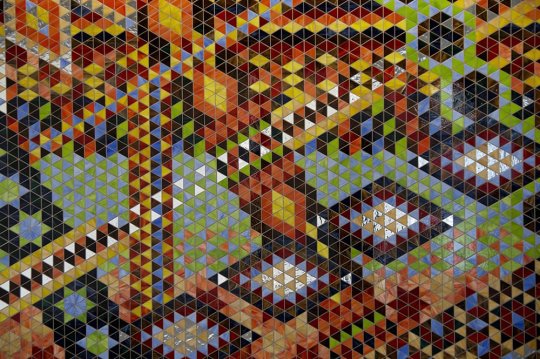
(Detail of Calder Community Mosaic by SpaceMakePlace Design (Rebecca Bayer & David Gregory - photo Doyle C. Marko)
The city of Edmonton is more vibrant thanks to a swath of public art installations over the past year. The Edmonton Arts Council public art and conservation teams were busy as they worked with artists from across Canada to place the final touches on artworks at Calder Library, ᐄᓃᐤ (ÎNÎW) River Lot 11∞ , Rossdale Linear Park, South Haven Cemetery, and Borden Natural Swimming Pool. In addition to new work, the conservation team took on more than 20 special projects, including cleaning bronze sculptures in two city parks, restoring the Norman Yates mural from the old Stanley Milner Library, and cleaning up Spectators for the Castle Downs Arena.

(Images from #YEGCanvas 2017-2018 clockwise by Elsa Robinson, Vanessa Ryl, and Kasie Campbell)
#YEGCanvas 2017/18 showcased 45 new works by local artists around the city on billboards and the LRT line.

(pehonan in the snow -artwork by Tiffany Shaw-Collinge, photo by Brad Crowfoot)
Perhaps the biggest public art news story of 2018 is the completion of ᐄᓃᐤ (ÎNÎW) River Lot 11∞ - Edmonton’s Indigenous Art Park. In development since 2013, the park was introduced to the public with a snowy opening ceremony on September 15. More than 75 people gathered at the site within Queen Elizabeth Park to celebrate the artists, artworks, and the spirit of collaboration that informed every stage of its development.
ᐄᓃᐤ (ÎNÎW) River Lot 11∞ is the result of a partnership among the City of Edmonton, Confederacy of Treaty No. 6 First Nations, Métis Nation of Alberta, and Edmonton Arts Council with substantial direction from Indigenous artists, Elders, knowledge holders, and community members. The park features contemporary works by six Canadian Indigenous artists that express “the stories of this place.”
The artists are: Amy Malbeuf (Rich Lake, Alberta), Tiffany Shaw-Collinge (Edmonton, Alberta), Duane Linklater (Moose Cree First Nation, Ontario), Jerry Whitehead (James Smith First Nation, Saskatchewan), Mary Anne Barkhouse (Nimpkish Band, Kwakiutl First Nation), and Marianne Nicolson (Dzawada'enuxw Nation). Candice Hopkins was the park curator.

(Sneak peek of a detail from Spring is Sprung, The Grass is Riz (I Wonder Where the Birdie Is?) by Karen Klassen & Erin Pankratz - photo, EAC)
In addition, some yet-to-be revealed works were installed at the Edmonton Valley Zoo and Dermott Park, while artists Sergio Serrano and Alexander Stewart will complete their artwork at Capilano Library early in the new year.
Read on for some images and descriptions and stay tuned in 2019 as new artworks are revealed!
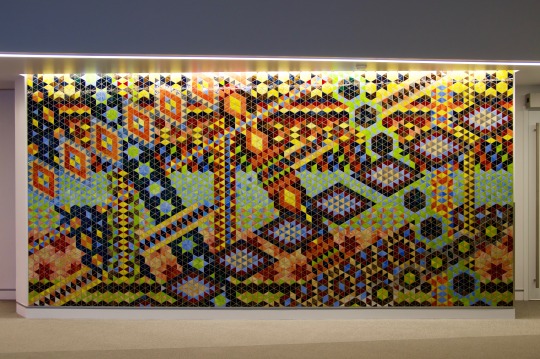
(Calder Community Mosaic - Rebecca Bayer & David Gregory, photo Doyle C. Marko)
Calder Community Mosaic fuses an ancient art form with 21st century techniques. The artwork is made from more than 7,500 triangular stained glass tiles. It measures 4.8m X 2.4m and sits in the Community Room at the Calder Library. The mosaic is visible from the library’s forecourt and welcomes all visitors in the universal languages of colour and geometric pattern.
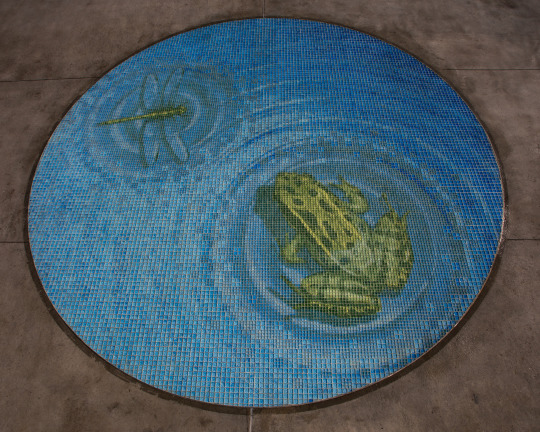
(One of the two mosaics that make up Ripples on a Pond by William Frymire at Borden Natural Swimming Pool - photo Aspen Zettel)
The artwork Ripples on a Pond is composed of two mosaics created by William Frymire. The colourful artworks resemble small ponds and feature three native Alberta aquatic species – the Western Painted Turtle, the Leopard Frog and the dragonfly. All are interdependent species susceptible to human modification of our natural environment, and key indicators of pond health. The mosaic’s illusion of a shallow pond conveys this message in a playful and fun manner while underlining the natural filtration of the pool’s ecosystem. Realized in a postmodernist style, this mosaic is a contemporary take on an ancient art form.
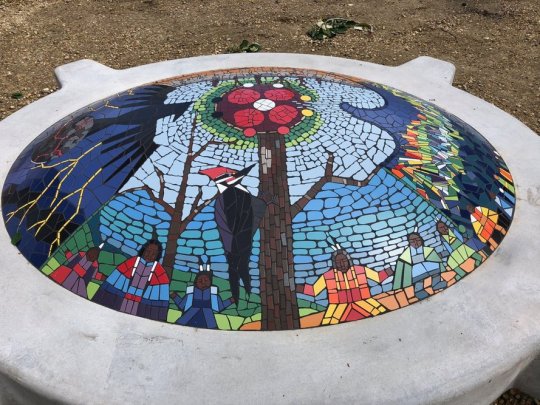
(mamohkamatowin (Helping One Another) by Jerry Whitehead photo by Brad Crowfoot)
Many nations, Indigenous and settler, helped shape the history of this place, amiskwaciy – “beaver house” in Cree. The theme of helping each other is inherent in mamohkamatowin, artists, artisans, and students came together to figure out the technical aspects, layer the mosaic tiles, and help bring the turtles to life. As they worked, shaping and adhering tiles, students from amiskwaciy Academy engaged with elders and knowledge holders who carry on the tradition of telling stories of this place. mamohkamatowin is a symbol of all these elements, and represents the stories of this place.

(mikikwan by Duane Linklater - video still by Conor McNally)
mikikwan is a concrete reproduction of a 9,000-year-old buffalo bone hide scraper from the archives of the Royal Alberta Museum. The artist chose the bone as his source material because of the many meanings, ideas, histories, narratives, languages and cultures embedded within it. The finished sculpture will memorialize the work of Indigenous women and the relation of that labour to the land. The sculpture also pays respect to the importance of the buffalo itself to the people living in this place, the communal aspect of its use, and its destruction with the arrival of Europeans on the Plains.
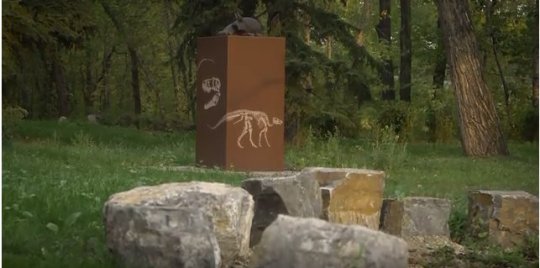
(Reign by Mary Anne Barkhouse - video still by Conor McNally)
From the echoes of trumpeting hadrosaurs traversing the valley floor, to being buried under a kilometre of ice, this territory has witnessed radical change over the years. It has been home to hunter and hunted alike, be it Albertosaurus and Edmontosaurus, or coyote and hare. The plants depicted have their own history as important to both body and soul. For those that have gone before, for that which has sustained and for those that have survived, Reign pays respect to the healing and adaptive nature of the land and to the original inhabitants of this territory.

(iskotew by Amy Malbeuf - video still by Conor McNally)
iskotew is a sculptural representation of the word “fire” in nehiyawewin (Cree language) syllabics: ᐃᐢᑯᑌᐤ. The colours chosen are based on colours that are seen in both historical and contemporary works as to illustrate the congruencies and survival within Indigenous cultures. The vibrancy of the colours are also congruent with the vibrancy of our cultures and languages. The nehiyawewin word for woman, iskwew, is derived from the word fire, therefore; iskotew connotes the sacred abilities of women, and the often unrecognized labours of Indigenous women who contributed to creating the place now known as Edmonton.

(Preparing to Cross the Sacred River by Marianne Nicolson - video still by Conor McNally)
Preparing to Cross the Sacred River references and acknowledges the natural formation of the North Saskatchewan River Valley banks, wildlife, and shared stories and traditions of Indigenous peoples. The stone slabs form a wall or “lookout” etched with images of “this place.” The artwork, which features sandblasted patterning reminiscent of beading styles, symbolizes the need to reconnect with ancient and sacred Indigenous beliefs to uphold our relationship to the land and protect the planet. Such activities must be built upon the foundation of ancient stories that tell how humans came to be in this place and how they must act within it.

(pehonan by Tiffany Shaw-Collinge - video still by Conor McNally)
This installation is inspired by the idea of pehonan (Cree – gathering or waiting place) and the oral traditions of Indigenous people as well as the many stories told of this area. It offers a space for teaching, storytelling, or performance. Conceptually, it references the oral roots of this place, and the ways in which stories change depending on proximity to the source. “The furthest back seat (at the top) references the deep past. It’s farthest from our reach when you are at the base, but when you are sitting at the top you have the greatest field of vision with perhaps the greatest perspective. When you sit on the lowest seat you are closest to the future, but not able to see to far into the distance.”

(One of the four sculptures that comprise The Magpies’ Nests by Chai Duncan & Kevin Sehn - photo Doyle C. Marko)
Rossdale Linear Park is a slice of nature in in an urban setting. The Magpies’ Nests considers the complex interactions between humans and nature as well as the concept of “home”. The welded steel nests on top of four plinths relate to structures found in Edmonton. The pyramid references the Muttart Conservatory; the cube stands in for local industrial buildings relating to ideas of innovation and productivity; the pentagonal prism, or house -shape, represents dwellings found the surrounding community; the sphere represents the magpie’s own expertly built domed nest.

(Night shot of Veil by Brandon McGillicuddy & Jeffrey Riedl at South Haven Cemetery - photo by Doyle C. Marko)
Veil is a large fabric-like lattice of airy line work appearing to billow from the South Haven Cemetery Service Building’s rectilinear geometry. The artwork’s delicacy and flow elegantly compliments the design and materials of the building it inhabits, and is empathetic to the sensitive context of the cemetery. The imagery evokes medieval Vanitas, or memento mori paintings, which reflect on mortality, the vanity of life, and transient nature of existence. Cloth, or empty clothing, is used to represent absence and loss. Veil represents loss in a non-religious way.
#yegarts#yegpublicart#publicart#iniwriverlot11#yegparks#indigenousart#canadianart#edmonton#edmontonartscouncil#cityofedmonton
2 notes
·
View notes
Text
Introducing the ᐄᓃᐤ (ÎNÎW) River Lot 11∞ Artists ~ Jerry Whitehead

(Artist Jerry Whitehead (r) with mosaic fabricators Erin Pankratz (l) and Karen Klassen (centre) at amiskwaciy Academy - photo, E. Pankratz)
ᐄᓃᐤ (ÎNÎW) River Lot 11∞ - Edmonton’s Indigenous Art Park opens this fall. The park features artworks by Mary Anne Barkhouse, Duane Linklater, Amy Malbeuf, Marianne Nicolson, and Tiffany Shaw-Collinge, and is near completion. In anticipation of the park opening, the YEGArts Blog is featuring conversations with the artists about their artworks and the inspirations behind them.
Today we feature Jerry Whitehead, a Vancouver-based Cree artist from the James Smith First Nation in Saskatchewan. His artwork is called mamohkamatowin (Helping Each Other)

(Both turtles installed at ᐄᓃᐤ (ÎNÎW) River Lot 11∞ and awaiting final landscaping - photo, C. Boida)
Edmonton Arts Council: How did you approach creating mamohkamatowin for the park? What inspired you?
When I looked at it, I liked the fact ᐄᓃᐤ (ÎNÎW) River Lot 11∞ is a park within a park – a little island. Then I wondered what I could do to make it interesting and I started thinking about the Cree creation story, which is like all Indigenous creation stories because they think of North America as Turtle Island. This got me thinking about turtles. I also had worked on a project in Vancouver where we did a big long retaining wall with mosaics in it – so I had that knowledge, then I thought, “I can paint, I can incorporate mosaics, because the turtle carries a mosaic on his back; he carries stories. They are one of the oldest creatures on earth, so if the turtles could talk, imagine the stories they could tell!”

(”Mother” Turtle installed - photo, C. Boida)
The workshop that was held for the shortlisted artists in October 2015 really gave me direction on the kinds of things I should put on the turtles. I didn’t want to put just “my art” on them. By getting all the Elders and knowledge holders together to talk to the artists, it really opened all kinds of possibilities for me!
EAC: You collaborated with high school students from Edmonton’s amiskwaciy Academy on the work. How did that come about?
That was funny! I was staying at the Nova Hotel, which is about a five-minute walk from the school. My friend was driving me around and said, ‘Hey, you know there’s a high school back here?’ So, we came over really quickly, and had a quick chat with Lloyd [Bloomfield], the Vice Principal at the time, and he said OK, they were happy to accommodate the project. Things just kept happening to connect us – it was a good thing. I love this school.

(Detail of pow wow dancer waiting for grout - photo, EAC)
EAC: How does mamohkamatowin fit in with your body of work?
I’ve been painting pow wow dancers for so long – they were such an important part of my childhood. You can see them throughout the art on both turtles. I’ve placed them at the bottom, so you are looking up at them. Everything that involves dancing, and that life, I think it just fits in with what’s being told about Edmonton. Dances tell stories, it’s storytelling.
EAC: Why did you choose mamohkamatowin as the title?
The whole project worked because people were helping each other continuously, throughout the process from the beginning. People helped me out at every stage; from the proposal writing, to the project management and fabrication. Even the project finale was at the school, getting the students involved. All of us involved at amiskwaciy Academy (including Elders, principals, tile artists) wanted to instil that in the students, how helping each other gets big things accomplished.

(”Baby” turtle installed - photo, C. Boida)
EAC: What does the orientation and placement of the turtles represent?
I thought of the river. The baby turtle, is facing north toward the river, but what I found [when I looked at a map] is it’s almost facing directly towards amiskwaciy [Academy]. The mother turtle is facing west toward the ocean. Each are facing water, but what I really like is that directional connection with the high school.
EAC: Could you walk us through the imagery on the turtles?
For the baby turtle, when I first came here last year to start him off, I didn’t really have a plan – I knew I wanted the kids to help out, but it can be tricky to coordinate them. [To come up with the plan] I borrowed the school logo and changed it up a bit. So, you could say the small turtle is dedicated to all the kids who helped out
We started out with a tiny baby turtle on top of the baby turtle, he helps to divide the “shell” into four sections

(South quadrant of the baby turtle - photo, C. Boida)
The red section faces south, and it represents the Métis people. You can see their flag, and the Elder suggested we put in some bear paws. There’s Métis imagery with the Red River Wagon and fiddle.

(Eastern quadrant of the baby turtle - photo, C. Boida)
Then we move to the east, which is the eagle. This section still has the paws in it. The eagle must always be on the east side.

(Northern face of the baby turtle - photo, C. Boida)
Moving to the north, is the buffalo on a white background. We added in the buffalo tracks and the skull. The Elder suggested we have the skull – because this is like the altar. In Native spirituality you see when they pray or have a sweat lodge, there’s a skull there.

(West face of the baby turtle - photo, C. Boida)
Toward the west are eagle feathers – they symbolize what the students have achieved when they complete their schooling here. This is where I started incorporating my dancers from babies into adults, and back again.
The large turtle is the mother turtle – her shell is also divided into four sections. The art on this turtle is more sophisticated – it’s been created with my assistants Erin Pankratz and Karen Klassen.

(Sweat lodge imagery on the mother turtle - photo, C. Boida)
The first thing we put on at the top, was the sweat lodge, the foundation of Native spirituality. Everything revolves around the sweat lodge.

(East side of mother turtle - photo, C. Boida)
Toward the east, we have the eagle again, going into the sweat lodge, with the Northern Lights below, and then my dancers come in again. The three pyramids are actually teepees signifying my three sons. Like a lot of artists, I use symbols to show how many children I have – so the number three comes up a lot. The dancers in this section are all different colours and they signify Edmonton – all the different ethnic groups here.

(South quadrant of mother turtle - photo, C. Boida)
The dancers keep moving into the next section, and here I incorporated some lettering [into their clothes]. I spelled tansi, which means ‘hello’ in Cree. This is the south side of the turtle, so we put in the woodpecker, which is symbolic of the Papaschase people, the original inhabitants of this place.

(Thunderbird and the creation of the world, west face of mother turtle - photo, C. Boida)
Continuing on to the west, we have the thunderbird. This is the creation of the earth – this is one of the stories Jerry Saddleback was telling – how the earth was formed, with lightning.

(Detail of the north-facing quadrant showing a spoon and arrowheads nestled in the archeological strata - photo, C. Boida)
At the workshop for the shortlisted artists in 2015, we all went on a river valley walk with Dr. Dwayne Donald from the U of A. He took us along the river bank and showed us the layers of sediment along the bank. The top part is recent Edmonton history – we included some bricks in there and a spoon. Then below this line on the lower level we have a couple of arrow heads to suggest the old history.

(North quadrant showing a beaver on the riverbank - photo, C. Boida)
We also put in a really colourful beaver here. All his colours refer to Edmonton and how diverse it is. He’s drinking some water and just enjoying himself!
These are meant for kids to interact with. Once they’re installed they’ll be the perfect height for kids to sit on and they can gently climb on the turtles’ backs.
#canadianindigenousart#yegpublicart#publicart#yegarts#iniwriverlot11#queenelizabethpark#artpark#canadianart#yegparks#yeg#edmonton#jerrywhitehead
7 notes
·
View notes
Text
Introducing the ᐄᓃᐤ (ÎNÎW) River Lot 11∞ Artists ~ Duane Linklater
youtube
ᐄᓃᐤ (ÎNÎW) River Lot 11∞ - Edmonton’s Indigenous Art Park opens tomorrow - September 15. For the past several months, the YEGArts Blog has featured the inspirations and thoughts behind the six artworks by Mary Anne Barkhouse, Amy Malbeuf, Marianne Nicolson, Tiffany Shaw-Collinge, and Jerry Whitehead that will feature there.
This final profile features mikikwan, by Duane Linklater, who is Omaskêko Ininiwak from Moose Cree First Nation in Northern Ontario.
Edmonton Arts Council: Here is Duane Linklater’s description of mikikwan:
“I have selected an ancient hide scraper, or as we call it in the Cree language ‘mikikwan’ from the collection of the Royal Alberta Museum in Edmonton Alberta, [increased in size and… fabricated in concrete]. In keeping with a previously developed methodology in my current art practice, I have excavated the collection of the Royal Alberta Museum and have identified a single hide scraper from the many thousands of objects at the museum.

(original hide scraper, found at the Royal Alberta Museum ~ photo courtesy of the artist)
This object, which is made of a lower leg bone of a bison, is approximately 9000 years old and was excavated by anthropologists in Alberta. Hide scrapers have been used for thousands of years in many areas in North America, and for the most part its design has changed very little. I am interested in articulating a presence with this object, a history and an ongoing contemporary practice of labor by Indigenous people in the Edmonton area”.
Duane Linklater’s artistic practice involves “the exploration of the physical and theoretical structures of the museum in relation to the current and historical conditions of Indigenous people and their objects and forms”. His sculptures, photography, films and video, installations and text works articulate these explorations.
The original artifact that launched the mikikwan project was excavated by anthropologists in Southern Alberta. The practice of hide scraping has been practiced by Indigenous peoples throughout Canada and remains important to many today. The practice is an essential component in the process of making animal hides usable for clothing, architectural use, for drums and rattles, amongst many things.
To create mikikwan, Linklater photographed the original hide scraper and began to work with Carvel Creative in Calgary to realize this significant object for ᐄᓃᐤ (ÎNÎW) River Lot 11∞.
The sculpture, cast in concrete, is many times larger than the original.
Linklater says, “It is these two decisions, which hopefully activate the hide scraper in new and unexplored ways from the position of the viewer. With an increased scale and a new material in cast concrete, mikikwan, deliberately aligned with the new Walterdale bridge, proposes this humble tool as a monument to the labor, practice and design of Indigenous people who still use this tool today”.
To read more about the concept and process behind mikikwan, visit Duane Linklater’s website mikikwan.com.
To experience mikikwan, please view this video by Conor McNally. Video - Conor McNally Sound - Dmitri Bandet Music - Matthew Cardinal Dolly Grip - Riley McNally
Special thanks: FAVA and Ryan Dupas

You are invited to attend the Grand Opening of ᐄᓃᐤ (ÎNÎW) River Lot 11∞ this Saturday, September 15 from 12:00-4:00 pm. The event takes place rain, snow, or shine!
The formal program begins at noon with comments from Wilton Littlechild, Grand Chief of the Confederacy of Treaty Six First Nations, Audrey Poitras, President, Métis Nation of Alberta, Mayor Don Iveson, Sanjay Shahani, Edmonton Arts Council. Candice Hopkins, Curator of ᐄᓃᐤ (ÎNÎW) River Lot 11∞, and Christine Frederick on behalf of the Steering Committee, among others.
The afternoon features an artistic fusion, programmed by Dreamspeakers, that showcases the scope, diversity, and vibrancy of Indigenous arts in Edmonton; an Artisans’ Market, and food trucks. You can also meet some of the artists behind ᐄᓃᐤ (ÎNÎW) River Lot 11∞. Click here for more details.
On September 16, M.A.D.E Edmonton will feature an InSitu artist talk and tour in the art park from 2:00-4:00 pm. Details are available here.
#yegarts#yegpublicart#canadianart#canadianindigenousart#canadianindigenousartists#duanelinklater#indigenousart#iniwriverlot11#yegparks#edmonton#queenelizabethpark#indigenousartists
3 notes
·
View notes
Photo

The opening for ᐄᓃᐤ (ÎNÎW) River Lot 11∞ is just over a month away. Artist Jerry Whitehead, working from a studio at @amiskwaciyacademy created mamohkamatowin (Helping Each Other). The first image is of the “mother” turtle carrying images of creation stories, and spirituality on her shell. The second, or “baby” turtle was created in collaboration with students and shows an interpretation of the school crest. You can read more at YEGArts.tumblr.com #yegarts #yegpublicart #iniwriverlot11 #canadianindigenousart #amiskwaciyacademy (at Edmonton Arts Council) https://www.instagram.com/p/BmgePxoAjjX/?utm_source=ig_tumblr_share&igshid=10tc0ipiqm9su
3 notes
·
View notes